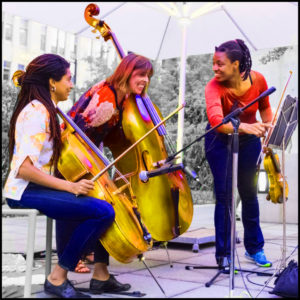Lollapalooza 2021 had some 385,000 attendees (without significant Covid-19 outbreak, fortunately) but featured little of host Chicago’s indigenous talent or styles. And that’s just wrong, declared Department of Cultural Affairs and Special Events commissioner Mark Kelly, launching the month-long Chicago in Tune “festival” at a reception August 19. Here’s the still-evolving event calendar of hundreds […]
MCA-Chicago’s Terrace concerts, acing outdoor presentation
Chicago’s Museum of Contemporary Art has aced outdoor music presentations with its Tuesdays on the Terrace series, most recently featuring the string trio Hear In Now performing strong yet sensitive chamber jazz. Drawing a thoroughly diversified crowd to enjoy fresh, creative music in open space on a summer afternoon for free (food and beverages extra) shouldn’t be […]
Announcing eyeJAZZ.tv & Happy 45th b’day AACM
eyeJAZZ.tv, a wave of guerrilla video music-news clips being initiated by the Jazz Journalists Association, has posted its first example — my brief production from last week’s 45th birthday concert of the AACM featuring composer-saxophonist Roscoe Mitchell, flutist and AACM chair Nicole Mitchell (no relation) and saxophonist Ari Brown, at Chicago’s Museum of Contemporary Art.
AACM at 45: “Creative Musicians” span generations, U.S., globe
The AACM — Association for the Advancement of Creative Musicians — continues after 45 years to encourage highly original, edgy and exciting artists — as I detail in my new City Arts column. Examples in New York City: reedist/composer Henry Threadgill’s Zooid performs tonight and tomorrow at Roulette; trumpeter Wadada Leo Smith’s 22-piece Silver Orchestra and the […]

